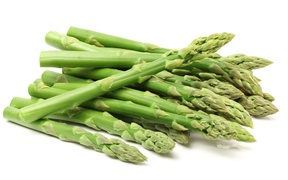
ASPARAGUS
This spring crop emerges from the soil in northern Europe in April-May. Wherever we live, we need to eat asparagus when it’s fresh and in season, not at other times of the year when it’s imported from the other side of the globe and flavorless.
White asparagus has grown under ground. Green asparagus gets its color from sunlight. Both have the same typical asparagus flavor but green asparagus is more like a typical vegetable while the white version has a more melting consistency.
White asparagus needs to be peeled while green asparagus – especially tender asparagus – only needs to lose the bottom end.
Choosing asparagus
Look for tender asparagus that doesn’t bend when you hold it by the base.
Whether it should be thick or thin is a matter of taste and also depends on what you are going to eat it with.
White or green? Follow the season and/or your preferences.
Storing asparagus
Asparagus needs to be eaten extremely fresh and should be stored as little as possible.
Asparagus will last about 2 days in the fridge if you wrap it in a damp cloth. Then put the cloth inside a plastic bag.
Another trick to storing asparagus is to put them upright in the fridge in water, like a bunch of tulips in a vase.
Asparagus that has lost its bounce can be frozen and/or used for asparagus soup.
Preparing asparagus
Remove the slightly woody bottom part of each stem. If you don’t know how much to take off, simply bend it down until the end snaps off.
White asparagus needs peeling. Use a potato peeler and pull it downwards from a point about a centimeter below the head. The fibrous, dry outer layer needs to be removed. Peeled asparagus should feel moist and soft. White asparagus can break easily when you’re peeling it. Put it on a chopping board. You can’t peel it firmly and quickly like you would a carrot.
When peeling asparagus, keep the peel and the ends and use them to make a stock for asparagus soup.
Protect the tips: The tips are the most attractive part of the asparagus. In a soup you can add the tips last, whole, after puréeing with a hand-held blender.
How to cook asparagus
White and green asparagus is good as it is, lightly boiled or steamed. Green asparagus is good as a crunchy element in a salad or pasta sauce, with salmon or shellfish, for example. Grilled and fried asparagus takes on a pleasant, smoky note.
You can get saucepans designed for cooking asparagus where the asparagus stands upright in a basket that is designed to fit the narrow container. If this is one of your favorite vegetables, it might be a good investment. One big advantage is that the tender tips that end up at the top, or if you have the right amount of water, slightly above the surface, don’t get overcooked.
Steaming asparagus is ideal because much of the mild flavor otherwise disappears into the cooking water. If you don’t have a steamer, a saucepan insert will work fine. Keep checking them with a skewer. Even steaming can result in overcooking.
If you’re grilling meat or fish: Add a foil parcel of asparagus, a little olive oil and a little salt to the grill. The asparagus can be cooked at a high temperature and makes an excellent accompaniment as a change from potatoes.
Deep fried asparagus! Try frying asparagus in a tempura batter, Japanese style.
Marinated asparagus is a good addition when you’ve finally had enough of asparagus’ own flavor. Here’s how: Dip the asparagus in boiling hot water. Take them out and place in a marinade of oil, balsamic vinegar, garlic and a pinch of salt. Leave to marinate for a while.
Make asparagus soup: Start by making a vegetable stock from all those left-over ends. Then cut the asparagus into pieces and save the tips. Cook the pieces in the stock, steam the tops quickly over the top. Purée the soup with a little crème fraîche and add the tips.
Cook it ”knackish”
You can pretty much figure out what this German word means from the way it sounds. Where kitchen Italian describes perfectly cooked pasta as ”al dente”, kitchen German describes perfectly cooked sparagus as ”knackish”. Asparagus that has been boiled knackish has springiness and body and some appetizing crunch left. It is thorooughly cooked through and still warm on the plate, the desired sensation being "fresh" but not "raw".
A bit like putting your teeth in a raddish that has undergone a rapid, invigorating steam bath...
Serving asparagus
Drain cooked asparagus on a cloth before placing on the plate. You really don’t want watery hollandaise.
Ideally present boiled or grilled whole asparagus full length with butter or olive oil, which makes them attractively shiny.
“Crisps” of air-dried ham that have dried further in the oven are an attractive and great tasting decoration for asparagus.
Asparagus cooked to destruction looks sad and should be hidden under a small mountain of parmesan, for example.
The classic
Carefully boiled or steamed asparagus with butter and sea salt. It’s no more difficult than that.








